

... Tom Palecki
By Scott Stilphen
As one Atari's product designers, Tom Palecki helped design the look for some of Atari's early computer products. Some of these, such as the 1050 Disk Drive, Trak-Ball, and Touch Tablet, became released products, while others remained vaporware or got as far as the prototype stage. How does a sketch become a fully-realized item? Read on!
DP: What inspired you to pursue a career in product design?
Tom
Palecki: I grew up as an artist and model builder and
decided that I wanted to keep doing what I always did, and get well paid for it.
DP: Whatís your educational background?
Tom Palecki: I have a B.S. degree in Product Design from Art Center College of Design, Los Angeles campus.
DP: How did the opportunity at Atari come about? Were they the first company you worked for?
Tom
Palecki: They werenít the first company I worked for.
I was working as the Industrial Design Manager at Xerox Corp. in Hayward, CA in
1982 when a young Designer, and good friend, who left the
company and had gone to work for the Atari Arcade group called to let me know
that there was a job opening in the Atari Home Computer group. So I applied for
it, did the usual interview and portfolio showing, and I got the job.
DP: When did you start at Atari? When did you leave?
Tom
Palecki: I started there at the end of August 1982 and
in July 1984 I was one of many that accepted a layoff when Jack Tramiel bought
the company from Warner Communications.
DP: What were your responsibilities there?
Tom Palecki: I hired on as a Senior Industrial Designer and just before I was laid off I was told I was being considered for promotion to Department Manager.
DP: How many product designers were there at Atari?
Tom Palecki: As far the number of product designers there I can't begin to tell you. I shared my office with 5 different designers while there on Plumeria in San Jose - Barry Marshall, Regan Cheng, Bob Lakes, and two others whose names I can't remember. I think there were 2 different groups at Corporate in Sunnyvale, and the Arcade group also in another location in San Jose.
DP: What was the development process like?
Tom Palecki: It was a lot faster than it was at Xerox. In 8 years at Xerox I worked on 4 major projects and several small ones. At Atari, in 2 years I worked on 5 major projects and several small ones. As for the process, it was the basic kick-off meeting with Marketing and Engineering, back to the office to start sketching a lot of design concepts, and then more meetings to refine the ideas. Once the final direction was determined, layout drawings were begun. It usually took about 2 weeks to work up the detail drawings, which were then sent to Asia to be translated into tooling drawings. The tooling drawings came back so we could do a final check to make sure the visual details were consistent with our original intent, and then the approved drawings were sent back to Asia. We also used some outside sources to have presentation models made so management could see what it was that we were up to way before the actual products came in.
DP: What were the hours in your department? Was your schedule fixed (i.e. 9 to 5) or could you basically come and go as you pleased?
Tom Palecki: The schedule was your basic 8:00 am to 5:00 pm, depending on what was happing at the moment. If things were cooking, we were putting in lots of extra hours. If it was slow, we still came in for the normal 8 hours, but we were told by our manager Kevin McKinsey that if we had any side work that we could do it there just so we looked like we were working. One of the coolest things was that we were also told that rather than falling asleep at our desks after lunch, that we could go play arcade games in one of the available games rooms that were located in several locations around the company. It wasnít cool to over-do it, though, and you could get in big trouble if you were caught abusing the privilege.
DP: You worked on designs for products in the Home Computer Group. Can you talk a bit about each of the products you worked on, the inspiration for your designs, the easiest/hardest part of designing each was, the people you worked with on them, etc?
Tom Palecki: To begin with, I arrived at Atari just as Regen Chang finished the console design for the 1200 Computer, so the designs of subsequent peripherals had to match the aesthetics of the 1200. In that vein, I did the 1050 Disk Drive and Touch Tablet, which was a departure in that it was mono color as opposed to the 1200 line, which was 2-tone. I think though that most of the controller products were done as mono color anyway:

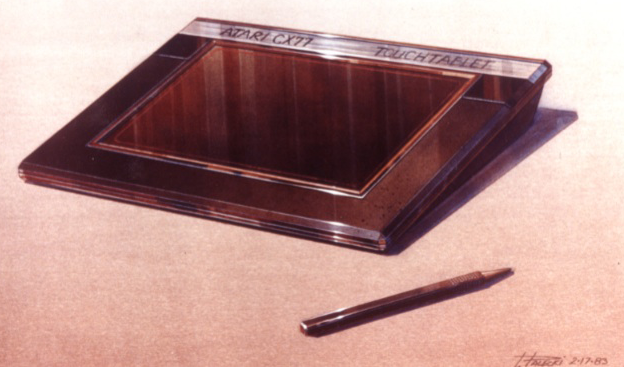
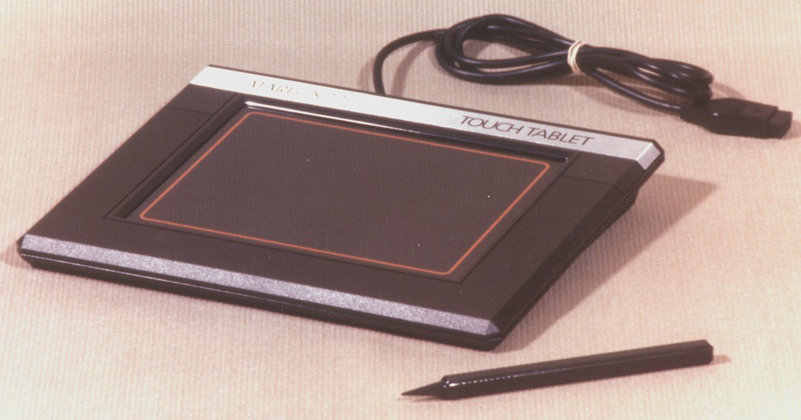
I then did a series of concept sketches for the Home Computer version of the Trak-Ball which were turned over to Barry Marshall, my officemate, to do the final design and draw it up for production.
I might add at this point that sometime before Barry left Atari and while we were office sharing, he did the design for the MindLink Head Band Controller. I donít remember how it came about, but I ended up designing the logo for that controller, which I worked up based visually on what a brain wave scan might look like in letter form. That was a smashing success and Kevin McKinsey was really proud of me for that one. Some office politics were involved in that logo design, which was part of the ďproudĒ thing.

DP: Can you expound a bit on the "office politics" regarding the MindLink logo?
Tom Palecki: Kevin McKinsey told me this once. He had been manager of ID and Graphics sometime before I came on board but at some point the two groups were split up and Kevin wasn't to happy about losing the Graphics group. So he and the other manager, I assumed, had some kind of small war going on. When I did the logo and then everyone liked it so much, Kevin I suppose, rubbed it in the face of the other manager he was sparring with, with great relish I'll bet.
DP: Did you also work on VCS products, such as the Pro-Line controllers, or add-ons such as the Voice Controller and Graduate?
Tom
Palecki: In a round about way I did work on the Home
Computer version of the Trak-Ball because I was sharing an office at the time
with Barry Marshall who was responsible for the design. I did get some 2 cents
in as Barry usually asked for my opinion during the design process of most of
the projects. It was a two-way street, as it was good to have someone there to
bounce ideas off of too.
DP: Were you involved with the 5200 case design?
Tom Palecki: No, the 5200 case was a Corporate Design Group thing (Sunnyvale). What I did have input on was the 7800, working with engineering on the case design. As I remember, Sharon Ashton was the mechanical designer and brought me in late in the development to offer assistance with the external details of the design. I believe we were still on Plumeria Street then. In 1984, after we moved over to Sunnyvale, is when I was assigned the task to design the companion keyboard for the 7800. That got as far as concept sketches when the hatchet fell.
DP: Were there any other projects that you worked on that ultimately never got released or even finished?
Tom Palecki: I did some concepts for Androbot, Credit Card Game Rom, and both Modular and Laptop computers.
Androbot: Nolan had opened up his Androbot project right on the other side of Plumeria Street and I guess asked if we could do some concept work on the robot. Kevin asked me to do the concepts, which I did, but I don't know the details of the transaction between the two companies. The freelance work was any outside design projects that we might be working on from time to time.
Credit Card ROMS: I seem to remember that around that time I read an article about the possibility of encapsulating some circuitry or chip in a credit card and about the same time I was working on the concepts for small portable computer products. So I incorporated that into the project. From that it developed into a stand alone project and Kevin then had me do some quick concepts for the Credit Card Roms.
Desk Top Computers: At one point there, same time frame as above, I was conceptualizing some new desk top computers. I was thinking about doing a complete vertical system that was sideways expandable by plugging the components together side to side instead of using a bunch of cables. The vertical components also had the advantage of acting like a chimney, drawing cooling air in at the bottom, flowing across the PCBs as it rose through enclosure and exiting at the top and could be positioned at the back of the desk top against the wall to save working space at the front of the desk. I had seen a photo of a "MAD" computer that a company (maybe MAD) had assembled from 3 components, a CPU, Monitor and Keyboard which were each a different design and color but were assembled as a modular system. So this was something I wanted to do with the desk top. I ended up designing the components as separate, modular pieces but matching in aesthetics. Where I changed each one was with different colors so each component was colored to reflect what type it was i.e. CPU, Monitor, Disk Drive, Keyboard, Printer, etc. I also envisioned the system with pastel silver colors on the enclosures. I have an early concept sketch which I'll try to dig up and will send you a copy. I'm disappointed that it never saw the light of day other than in my sketch.
1200 Series Game Carts: This was a concept to production project to update the game cartridges to reflect the new aesthetics of the Home Computer products. The concept that won out and went to production copied the basic aesthetic of the vent pattern on the 1200 series product line and as a raised pattern on the sides of the carts acted as a grip for inserting and removing them.
DP: Sounds like the cart shells that were used for the XEGS.
Tom Palecki: As far as them being used on the XEGS system that's the first I've heard of it. (after seeing photo) Yes, I believe that's the one I designed. They probably used the same molds and just shot them in that awful color. Just Googled the system - OUCH!, sorry but that's an AWFUL design. That must have been done after I left the company.
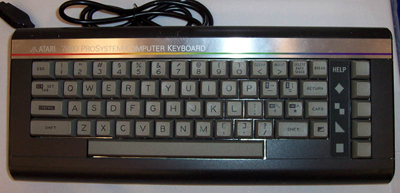
One of them that got away was the 1029 Printer. It was one of my favorite projects and apparently only saw limited release in Europe as Atari was tanking. I was pretty disappointed as that was my favorite of the bunch.
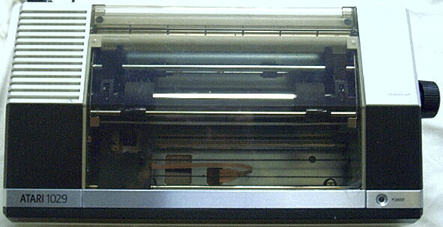
After things started to go down hill, I was assigned to work on the 7800 Keyboard project, which was to do a basic design match-up to the 7800 console aesthetics and also design the cable-attached plug-in module.
DP: The modular and laptop computer concepts, were these for some of the computers in development, such as the EVA (laptop featuring plug-in modules) and Dream One (a briefcase computer by Cyan Engineering that was influenced by Alan Kay's Dynabook laptop computer concept)?
Tom Palecki: I was just asked by Kevin McKinsey to sketch up a bunch of advanced concepts for that type of product which I did but there was no underlying direction given for a particular product. It was all Blue Sky work which I was pretty excited about at the time.
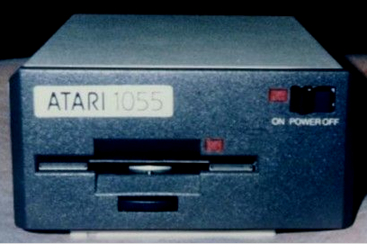 DP:
Did you also work on the 1055 3.5Ē disk drive?
DP:
Did you also work on the 1055 3.5Ē disk drive?
Tom Palecki: I believe that was the small sheet metal-enclosed drive and yes, I did the layout drawings for the sheet metal but that was about it.
DP: What were some of your experiences working for Atari? Do you have any stories or anecdotes from those days that you relate for
Tom
Palecki: One the great extra-curricular activities
that were available to us were the monthly, Friday evening Engineering group
parties. They were a pot luck event with lots of great eats, beer kegs, music,
and dancing. They were held back in the shipping dock area of our building and a
good time was had by all. I guess it was the Silicon Valley party-hearty thing
at the time.
Another highlight was when I did the design for the Atari Touch Tablet. I was in
a meeting with Kevin and the marketing guys when some one brought up the
question of who was going to demo the tablet at the 1983 CES show in Chicago? It
got quiet, no one was saying anything, so I said, ďIíll do itĒ and I got the
job. I was sent to Chicago, did the demo at the show, and had another great time
while working for Atari.
DP: I also used to have a Touch Tablet and absolutely loved using it. It's a shame that more software wasn't written to take advantage of. Besides the Atari Artist cart, the only other program I recall that supported it was a drawing program from ANTIC magazine called RAMbrandt.
Tom Palecki: I am an Alumni of the Art Center College of Design, later in the summer 1984 I got wind that Art Center was starting to set up a computer graphics lab at the new campus in Pasadena, CA so I decided to try to get them interested in using Touch Tablets in their lab. I got in touch with the lady who was setting it all up, arranged a meeting and demoed the tablet for her. I also got a hold of Atari Marketing to arrange for them to meet with the Art Center people and donate several tablets for publicity purposes. All was going well when again, the hatchet fell.
DP: Did you ever have
the feeling at any point during your time there that Atari was perhaps "too big"
for its own good?
Tom Palecki: I never really thought about it because I enjoyed working there so much. In hind-sight now I can see some of the problems they were having but at the time we were having just too much fun to think about it.
Just a side note to the layoff. On the last day, Dave Schenone and I were taken out to lunch by the new product design manager and during our conversation with him it came out that "HE" was going to be doing all of the new designs and we would get to be liaison to outside vendors. So when asked the big question, we both said NO! Dave went on to another couple of jobs and ended up Tandem computers and worked his way up to dept. manager there. I stayed at home for a while then several of the engineers I had worked with called to ask me if I could take on some freelance work for them. That worked out nice for me and set me on a new track of working for myself which I'm still doing today. Dave Schenone went on to become the Director of Footware Design at Nike and of course I got a lot of work from him as well.
DP: Can you describe your career, between then and now, and where youíre currently working?
Tom
Palecki: In what was for me an interesting turn of
events is that, after being laid off in 1984, I was pursuing another in-house
designer position but with very little luck. As it turned out, I started getting
calls at home from several people I had worked with at Atari to do some
freelance work for them at their new in-house jobs. So thatís pretty much where
my new self-employed life began; I have been self-employed ever since. I started
to wear a bunch of different hats, so to speak, and picked up product design
work, did ad graphics for some local agencies, ID model building, started
building custom electric guitars, did guitar repairs, paint jobs, logo design,
and ad graphics and banners for local bay area bands. The guitar and ID models
business grew to the point where I needed to get out of my garage and into
commercial space, which I did in 1991. The ID model building business was also
increasing then too, so the new work space was a perfect step up.
Itís very interesting how things come at you while youíre looking the other way
too. In 1996 I was informed that the rent on my space was to increase by over
50%, and at that time commercial space happened to be under-priced. So I took
another step up and purchased an industrial condo in a building just down the
street from the rental. It was twice the space for the same price as the rental
would have been had I stayed there. Convenient? Yes! I moved in early '97. The
guitar business dropped off in about '95 but the ID model business was really
cooking, so that became my main source of income. I was also able to bring in
some contract workers, mostly new design grads from San Jose State, to help with
the work load. I operated in that manner until July of '07 when we closed up and
moved to Arizona, near Sedona,
where we wanted to do other things including new websites, types of work, etc.
I let my peardesign.com website lapse but haven't yet set up a new one. We
moved all of my equipment here and put it in storage until we could get a new
shop/office building built on our rural property. Not the greatest time to make
a move like that, but things are stabilizing now and work is coming back in so
thatís pretty much the road Iíve traveled since leaving Atari. I tell anyone
that will listen though that the Atari experience was one the best Iíve had in
my career.
One of my new endeavors is AZ Guitars, which I'm setting up now and will follow up with a website soon. I'm also partner in company that produces and sells a patented Guitar and Bass string winder called "Turbotune". My partner, Dave Jeffrey, came up with the concept, asked me to help him develop it, and offered me a piece of the action. That's another website we need to get up and running as well. I'm also named on several other patents in different product areas too.
DP: Which of your titles are your favorite, and what types of games in general?
Tom Palecki: At the time I liked (not all of them Atari games) Phobos, Caverns of Mars, Miner, Bruce Lee, Millipede, Tetris, and many more. If anyone is interested I have a couple of binders full of old 5Ē floppy game disks from those days that Iíd be willing to part with.
DP: Do you still own any of the products you worked on, either as a keepsake, or to show friends or family?
Tom Palecki: The only thing I have left is an in-the-original box, Atari Touch Tablet. I sold all of my other computer and peripheral products.
DP: Have you stayed in touch with any of your former co-workers?
Tom Palecki: No, Iíve lost track of all of them. Every once in a while I try to see if I can find someone but theyíre hiding out there somewhere.
DP: What are your thoughts on how the industry has evolved?
Tom Palecki: Compared to the technology back then, Iím completely amazed at the progress thatís been made on game graphics and interaction with the players. I donít play video games anymore as I still need to do what I do to make a living, but sometimes I think it would be fun to play some of the old games. By the way, and itís a big one for me, as far as the Atari game players are concerned, the best controllers ever are/were the original square-box, 2600 joysticks. I tried most of the updated ones and they were a pain to use compared to the originals.
| GAMEOLOGY |
| GAME | SYSTEM | COMPANY | STATUS |
| 1029 Printer | Atari Inc. | released | |
| 1050 Disk Drive | Atari Inc. | released | |
| 7800 Keyboard | Atari Inc. | not released | |
| Androbot - Concepts | Atari Inc. | released | |
| Atari Touch Tablet | Atari Inc. | released | |
| Credit Card Game Rom - Concepts | Atari Inc. | not released | |
| Desk top | Atari Inc. | ||
| Game Cartridges - 1200 series | Atari Inc. | released | |
| Modular and Laptop computers Ė Concepts | Atari Inc. | not released | |
| Trak-Ball Ė Concepts | Atari Inc. | released |